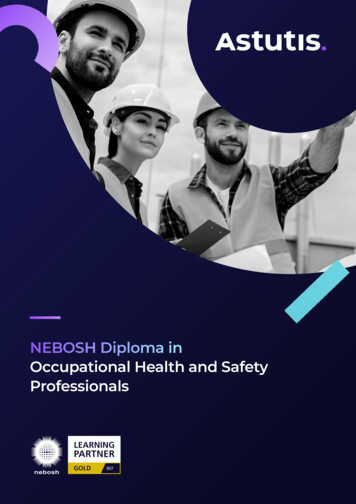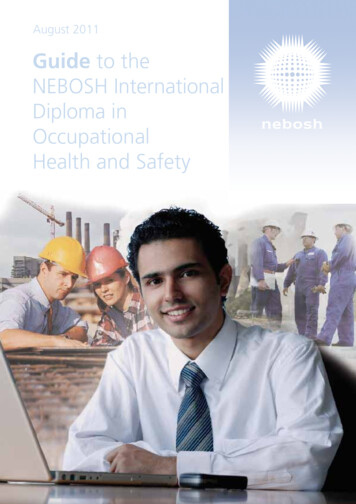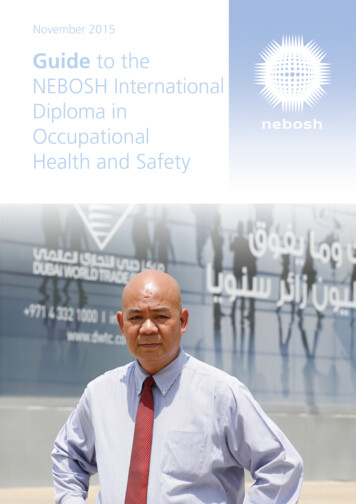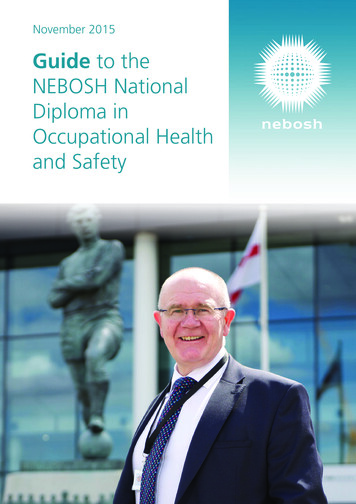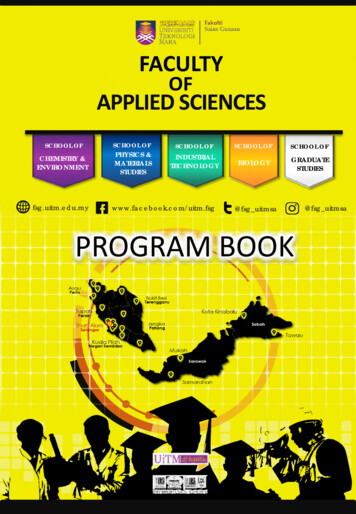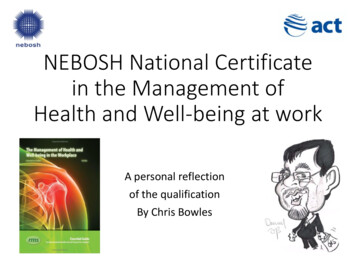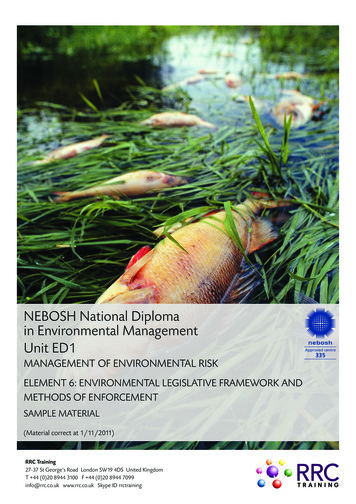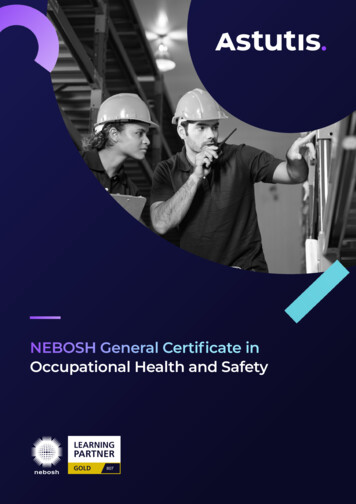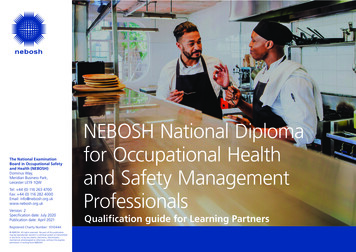
Transcription
The National ExaminationBoard in Occupational Safetyand Health (NEBOSH)Dominus Way,Meridian Business Park,Leicester LE19 1QWTel: 44 (0) 116 263 4700Fax: 44 (0) 116 282 4000Email: info@nebosh.org.ukwww.nebosh.org.ukVersion: 2Specification date: July 2020Publication date: April 2021Registered Charity Number: 1010444 NEBOSH. All rights reserved. No part of this publicationmay be reproduced, stored in a retrieval system or transmittedin any form, or by any means, electronic, electrostatic,mechanical, photocopied or otherwise, without the expresspermission in writing from NEBOSH.NEBOSH National Diplomafor Occupational Healthand Safety ManagementProfessionalsQualification guide for Learning Partners
CourseOverviewContentsQualification overviewQualification key features4Qualification summaryIntroduction6Qualification type6Syllabus development and review7Entry requirements and minimum standard of English for learners8Notional learning hours9Assessment formats10Qualification grading and issue of qualification parchment10Re-sitting units11Teaching of syllabus content11Conflict of interest11Tutor references11Minimum standard of English required for tutors12Available resources12SyllabusLearning outcomes14Part 1 – knowledge/thinking/planning15Unit ND1: Know – workplace health and safety principles (UK)Part 2 – doing1542Unit ND2: Do – controlling workplace health issues (UK)42Unit ND3: Do – controlling workplace safety issues (UK)59Prior learning74
Qualification overview
Qualification key featuresQualificationoverviewUnit prefixes and titlesAssessmentUnit ND1Unit ND2Unit ND3Unit ND1: Know – workplace health and safety principles (UK)Unit ND2: Do – controlling workplace health issues (UK)Unit ND3: Do – controlling workplace safety issues (UK)Assessment typeAssessment timePass marksAssignment60 hours (approx.)Notional 50%Case study40 hours (approx.)Notional 50%Case study40 hours (approx.)Notional 50%(see ‘Assessment formats’ for more detail)Notional learninghoursUnit ND1: 195Unit ND2: 145Unit ND3: 135(See ‘Notional learning hours’ for a breakdown of the hours)Qualification level andnumber of creditsSCQF Level 10 (Equivalent to RQF Level 6) with 49 creditsModes of studyEntry requirementsA full-time block release course (minimum of six weeks (30 working days))Part-time day release (spread over at least 30 weeks)Open, distance learning, eLearningNo formal entry requirements but due to there being assumed knowledge (see‘Prior learning’ section) it is recommended that learners have passed the NEBOSHNational General Certificate in Occupational Health and Safety or an equivalentSCQF Level 6 or 7 qualification. See ‘Entry requirements and recommendedminimum standard of English’ for further information.Recommendedminimum standards ofEnglishLearner: International English Language Testing System (IELTS): 7.0 or higherTutors: International English Language Testing System (IELTS): 8.0 or higherQualification gradesThe percentage marks of all three units are combined and the qualificationgrade is based on the following boundaries:Distinction: 226 or higherCredit:196 - 225Pass:150 - 195NEBOSH National Diploma for Occupational Health and Safety Management Professionals4
Qualification summary
QualificationsummaryIntroductionThe NEBOSH National Diploma is the flagship NEBOSHqualification and, when launched in 1988, was the firstUK vocational qualification to be developed specificallyfor health and safety professionals. The NationalDiploma is recognised and reliable; over 20,000 learnershave achieved the qualification since its introduction.The NEBOSH National Diploma is the qualification foraspiring health and safety professionals, building directlyupon the foundation of knowledge provided by theNEBOSH National General Certificate. It is designed toprovide learners with the knowledge and understandingrequired for undertaking a career as a health and safetyprofessional and it also provides a sound basis forprogression to postgraduate study.The qualification deliberately looks at general workplaceissues so that is can be applied in the many differentsectors in which health and safety professional maywork. On completion of the qualification, your learnerswill be able to: Understand how health and safety legislation isapplied in a workplace and the possible enforcementactions that could be taken for non-complianceand how they contribute to health and safety legalactions. Use different types of health and safety leadershipapproaches and to be able to influence health andsafety issues at all levels. Influence organisational and health and safetyworkplace culture. Proactively manage health and safety, taking accountof human failures and factors. Manage health and safety competence (both theirown and that of the organisation). Use a range of hazard identification, riskmanagement and loss causation techniques. Monitor health and safety performance. Develop their role as a health and safety professionalincluding understanding how it links with CorporateSocial Responsibility. Effectively manage organisational change. Manage contractors and supply chains. Control a range of workplace health and wellbeingissues. Control a range of workplace safety issues.Qualification typeNEBOSH offers Vocationally-Related Qualifications (VRQs)in England, Wales and Northern Ireland. In Scotland,VRQs are known as ‘Other accredited qualifications’.VRQs provide the knowledge and practical skills requiredfor particular job roles through a structured, studybased training programme that combines the testing ofknowledge and understanding in written examinationswith practical application of learning in the workplace.VRQs are a popular type of qualification because theyare nationally recognised, flexible and offer routes forprogression to employment or further study.NEBOSH National Diploma for Occupational Health and Safety Management Professionals6
QualificationsummarySyllabus development and reviewThe syllabus has been developed by NEBOSHfollowing extensive consultation with keystakeholders, notably previous Diploma learners,Learning Partners, subject experts and employers.NEBOSH would like to take this opportunity to thankall those who participated in the redevelopment andimplementation of this qualification but, in particular,the following individuals and employers:Simon BownKeolisAmey Docklands LtdDavid CampbellNetwork RailStewart MardleBTLouisa MeadGary SwayneAPS GroupRoger SchulpBPDarren WebbNewsprinters (Broxbourne) LtdNo ‘stick in the mud’when it comes toadventureClaire Guise has thrown herselfinto a number of challengesin recent years. Not only hasshe trekked across Vietnam,conquered the Grand Canyonand hiked along the Great Wallof China, she’s also completedher NEBOSH National Diploma in Occupational Healthand Safety.Her achievements have been motivated by the charityMarie Curie, where Claire is employed as Health andSafety Manager. Claire has responsibility for health andsafety across the organisation, which employs morethan 2,000 nurses.“There are a surprising number of issues that needto be managed here” explained Claire. “Besides theusual day to day risks, there’s fire safety, issues aroundconstruction and contractors and, of course, all theexciting creative ideas our fundraising come up with.Taking the NEBOSH Diploma has helped tremendouslywith the depth of knowledge I’ve needed here at MarieCurie and with applying that knowledge of course.Tunnel vision is certainly not what’s required here. It’salso very important to keep that knowledge up to dateand being part of the NEBOSH Alumni has been reallybeneficial from that perspective”.NEBOSH National Diploma for Occupational Health and Safety Management Professionals7
QualificationsummaryEntry requirements and minimum standardsof English for learnersThe NEBOSH National Diploma syllabus assumes thatlearners will have knowledge of health and safetyequivalent to that provided by the NEBOSH NationalGeneral Certificate (NGC).Many learners embark on the National Diplomaalready having gained health and safety knowledgeeither through previous study of the NGC, or a similarqualification. To avoid unnecessary duplication, increasevalue and provide progression for learners, the July2020 specification of the National Diploma excludesmuch of the content that is already adequately coveredin the NGC (this is classed as prior learning). The priorlearning syllabus content that previously formed part ofthe National Diploma (November 2015 specification) andalso forms part of the NGC (October 2018 and November2014 specifications) is shown in the ‘Prior learning’section of this Guide.Further information on the NGC can be foundvia our website ates.to take the NGC first. Either way, you must be satisfiedthat your learners are ready to undertake the significantdemands and commitment inherent in studying theDiploma.Standard of English requiredYour learners must be proficient in the use of writtenEnglish. This is because the assessments are currentlyoffered (and must be answered) in English only. Thestandard of English required by learners studying for theNEBOSH National Diploma must be such that they canboth understand and articulate the concepts containedin the syllabus. It is important to stress that it is theresponsibility of Learning Partners to determine theirlearners’ standards of proficiency in English.NEBOSH recommends that learners undertaking thisqualification should reach a minimum standard of Englishequivalent to an International English Language TestingSystem (IELTS) score of 7.0 or higher in order to beaccepted onto a National Diploma programme.Further information on IELTS can be found here tion.To ensure that learners will have this prior learning, it isstrongly recommended that learners achieve the NGC orequivalent qualification prior to undertaking the Diplomacourse. However, we do not want this to be a barrier soyou could also assess prior learning in some other waysuch as through a diagnostic questionnaire to establishbroad topic understanding. The results of this could theninform a recommendation as to whether to proceeddirectly to Diploma study (albeit with additional supportand self-study to fill small knowledge gaps) or whetherNEBOSH National Diploma for Occupational Health and Safety Management Professionals8
QualificationsummaryNotional learning hoursThe qualification has the following notional learninghours:UnitNotional learning hoursCreditsTaughthoursSelf-studyhoursAssessment Total 1414414047549Total 191A programme of study therefore needs to be basedaround a minimum of 191 taught hours andapproximately 144 hours of self-study for an overalltotal of 335 hours (excluding assessment time).A full-time block release course would be expectedto last for a minimum of 6 weeks (30 working days– teaching for 7 hours per day) and a part-time dayrelease course would be spread over at least 30weeks. The tuition hours should be added to therecommended self-study hours to give the minimumnumber of hours for learners studying by open,distance learning or e-Learning.Tuition time should normally be allocatedproportionate to the tuition time for each elementbut may require adjustment to reflect the needs of aparticular learner group.NEBOSH set me upfor successWhen Matt McDonnell,Health and Safety Adviser atB&Q, talks about health andsafety, he tends to focus onthe needs of his colleagues aswell as the technical processesinvolved. It’s hardly surprisinggiven his background as aretail manager. Successfulretailers tend to be customerorientated rather than simply being product focused.Matt told us: “I absolutely love this job, especiallywhen you give someone a little nugget of safety adviceand you see the penny drop. As a safety professionalyou want to make a difference and you want yourcolleagues to respond positively. For me, this is the keyto protecting everyone from harm.NEBOSH really set me up for success and helped medevelop my career quite rapidly. After deciding not togo to university earlier in my life I’m really proud of myDiploma qualification. One of the reasons I chose theDiploma was the prestige that surrounds it. Everyonerecognises there is a genuine challenge in achievingthe NEBOSH Diploma and there’s also great confidencein it. It gives B&Q reassurance and kudos to say theyhave a NEBOSH Diploma holder offering competentadvice”.NEBOSH National Diploma for Occupational Health and Safety Management Professionals9
Assessment formatsQualification grading and issue of parchmentsTo achieve the National Diploma, learners mustcomplete and pass the following assessments.Learners must achieve a ‘Pass’ in all three units to achievethe qualification. The pass standards are given in the‘Qualification key features’ table.ND1Assignment (in four parts - simulations, workplacebased activities, reflective tasks and a research project)ND2Case study (simulation only)ND3Case study (simulation only)Part of the Unit ND1 assessment will require yourlearners to undertake some workplace-based activities.Your learners will, therefore, need to ensure thatthey select a suitable workplace/organisation. Theworkplace/organisation does not have to be theirown; it just needs to be suitable. The selectedworkplace should provide sufficient scope to carry outa range of activities. If a learner has difficulty finding asuitable workplace, you must help the learner to makearrangements. The workplace activities will be drawnfrom the following assessment criteria:Assessment Topiccriteria2.3Consultation2.4Health and safety culture3.1Competence, training, information and supervision3.2High reliability organisations4.2Sensible risk management/types of risk assessment/implementing risk assessment actions4.3Risk profile only5.2Health and safety monitoring and measuring7.3Organisation change9.1General management of contractorsThe percentage marks of all three units are combined andthe qualification grade is based on the boundaries shownin the diagram below.If a learner has retaken a unit to achieve a higher mark,the highest unit mark will be used to calculate thequalification grade.Once the third successful unit has been completed, thelearner will be issued with a qualification parchment.Parchments are normally issued 20 working days after theresults declaration date for the third successful unit.226 Assessment format150 - 195 196 - 225Unit0 - 149QualificationsummaryNEBOSH National Diploma for Occupational Health and Safety Management ProfessionalsDistinctionCreditPassRefer10
QualificationsummaryRe-sitting unitsConflict of interestIf a learner does not achieve a ‘Pass’, the learner mayre-sit the unit(s) in which they have been unsuccessfulproviding that this happens within the 5-year enrolmentperiod. However, each re-sit will incur an additional fee.Learning Partner staff (including Head of LearningPartners, Tutors, Administrators, Examinations Officersand Invigilators) must declare in writing to NEBOSHany employment and/or familial, spousal or other closepersonal relationship with any examination or assessmentcandidate. Further information can be found in the‘Instructions for Conducting Examinations’ document.Learners may re-sit unit(s) at any time within theirenrolment period. This includes re-sitting successfulunit(s) to try to improve the qualification grade. Whenall three units have been successfully completed, learnerswill need to inform NEBOSH of their intention to re-sitthe successful unit(s) within 20-working days of theresults declaration date for the final successful unit.There is no limit to the number of re-sits which can betaken within the enrolment period.If a learner sits a unit more than once, the highestgrade achieved will count towards the final qualificationgrading.Tutor referencesThese references are given to aid tutors with the teachingof the syllabus content; they are not an exhaustive list andtutors can use other references to those given. The tutorreferences are no longer included in the Guide but areavailable from the ‘Qualification’s Resources’ section onthe NEBOSH website.If a learner registers for any unit of the National Diplomawhilst awaiting a result from a previous assessment, thelearner cannot then request a refund of the registrationfee if the awaited resulted is a ‘Pass’ (except in the case ofan Enquiry About Result).Teaching of syllabus contentAlthough the syllabus sets out the units and elements in aspecific order, tutors can teach the units and elements inany order they feel is appropriate. Learning Partners willneed to reflect this in the timetables which are submittedfor approval as part of the accreditation/re-accreditationprocess.NEBOSH National Diploma for Occupational Health and Safety Management Professionals11
QualificationsummaryMinimum standard of English required fortutorsTutors must have a good standard of English. Theymust be able to articulate the concepts contained inthe syllabus. If the tutor’s first language is not English,the Learning Partner must provide evidence of thetutor’s standard of English when submitting the CV forapproval.NEBOSH’s requirement is for tutors delivering thisqualification to have reached a minimum standard ofEnglish equivalent to an International English LanguageTesting System score of 8.0 or higher.Available resourcesIn addition to this guide, the following resources aredownloadable from the NEBOSH website: Tutor references; Leaflet; Case studies.Find your voice with a NEBOSHDiplomaCrystal Danbury is Safety Director atOpenreach, an organisation that is vital tothe UK’s national infrastructure and whichemploys around 33,000 people. Her roleis strategic. After joining Openreach shereviewed safety performance and internalcapabilities, which led to her forging a5-year plan.Crystal’s approach puts a great deal of emphasis on engagingsupervisors and frontline workers across Openreach aiming to ensurethat they not only implement safety strategy, but also feel inspired todevise supporting solutions of their own.“Perhaps it’s because I started out as a technician and I knowwhat it can be like to sometimes find yourself discounted from theconversation around safety. It’s what lies behind my safety ethos ofalways trying to make sure everyone has a voice.”Crystal also highlights NEBOSH as having played a big part in hercareer success. “It’s often said that a NEBOSH Diploma opens doorsfor you, and since I passed mine (National Diploma in OccupationalHealth and Safety) back in 2010 I’ve definitely seen that first hand. Imake no apologies for saying that for me NEBOSH holds somethingreally special and it gives me huge confidence in members of myteam when I know they too have that. I always say if you wantto pursue a career in safety and you want a good grounding,something to make you feel confident, something to make you feelcompetent and something you will draw on every day at work, thenNEBOSH is a fantastic way to go. People sit up and listen when youhave a NEBOSH Diploma. It helps you find your voice. Yes, you needpassion, drive, a great set of soft skills and a clear ethos aroundsafety, but you also need something that will help you take ongreater levels of responsibility and NEBOSH is unbeatable for that.”NEBOSH National Diploma for Occupational Health and Safety Management Professionals12
Syllabus
Learning outcomesSyllabusLearning outcomeTaughthoursRecommendedself-study hoursAssessment58Unit ND1assignment1You will be able to source, develop, evaluate and interpret relevant health and safety information(such as legislation, guidance, best practice, procedures) and communicate it effectively to thosewho need it (both within your organisation and those affected by your organisation’s activitiessuch as contractors and insurers).162You will be able to promote a positive health and safety culture by: gaining commitment and participation; and engaging, supporting and influencing leaders (and others) to change attitudes andbehaviour and make health and safety a priority.193You will be able to assess, develop and maintain individual and organisational health and safetycompetence.54You will be able to understand risk management including the techniques for identifyinghazards, the different types of risk assessment, considerations when implementing sensible andproportionate additional control measures and developing a risk management strategy.65You will be able to develop and implement proactive and reactive health and safety monitoringsystems and carry out reviews and auditing of such systems.126You will be able to continually develop your own professional skills and ethics to actively influenceimprovements in health and safety by providing persuasive arguments to workers at all levels.57You will be able to develop a health and safety policy strategy within your organisation (includingproactive safety, Corporate Social Responsibility and the change management process).58You will be able to contribute to health and safety legal actions.49You will be able to manage contractors and supply chains to ensure compliance with health andsafety standards.310You will be able to advise the organisation on a range of common workplace health issues/hazards including how these can be assessed and controlled and the legal duties associated withthese issues/hazards.6045Unit ND2case study11You will be able to advise the organisation on a range of common workplace safety issues/hazards including how these can be assessed and controlled and the legal duties associated withthese issues/hazards.5441Unit ND3case studyNEBOSH National Diploma for Occupational Health and Safety Management Professionals14
Part 1 – knowledge/thinking/planningSyllabusUnit ND1: Know – workplace health and safety principles (UK)Learning outcome 1You will be able to source, develop, evaluate and interpret relevant health and safety information (such as legislation, guidance,best practice, procedures) and communicate it effectively to those who need it (both within your organisation and those affectedby your organisation’s activities such as contractors and insurers).Cross reference with assessment criteria 9.1 – manage contractors and supply chains to ensure compliance with health and safetyAssessment criteriaTopicRefOutline how RegulationsHealth1.1are created.and safetyContent Creating health and safety regulations: procedure under section 15 of the Health and Safety at Work etc. Act 1974regulations- permissible subject matter of Regulations role of the Secretary of State and the HSE in making Regulations the various stages of consultation the statutory procedures for making approved codes of practice.Describe the possibleProsecutions1.2routes that a criminal case The possible routes that a criminal case could take (including appeals) through the court system inthe UKcould take through the UK The basic procedures for bringing prosecutions for breaches of health and safety legislation and forpursuing civil actions cross reference with assessment criteria 8.1 and 8.3.court system and the basicprocedure for bringingprosecutions.Know, and be ableto advise on, theresponsibilities and powersof enforcing officersand the principles ofenforcement, enforcementoptions and enforcementpenalties.Enforcement1.3 The obligations of enforcing officers: duty to give information to workers or their representatives; theduty not to disclose information (Health and Safety at Work etc. Act Section 28) The principles of enforcement with reference to the HSE’s Enforcement policy statement (HSE41):proportionality of enforcement; consistency of approach; transparency Enforcement options (where there has been a material breach) Cross reference with assessmentcriteria 1.2 choice of enforcement option linked to the HSE’s Enforcement Management Model (EMM)NEBOSH National Diploma for Occupational Health and Safety Management Professionals15
SyllabusAssessment criteriaTopicRefContent1.3 The application of common law Individual Gross Negligence manslaughter (culpable homicide inScotland) to work-related accident/incidents The legal criteria for prosecution and possible sentences under the Corporate Manslaughter andCorporate Homicide Act 2007 The factors a judge will consider when passing sentence for health and safety offences withreference to the Health and Safety Offences and Corporate Manslaughter guidelines published bythe Sentencing Council.Understand the liabilityfor damages (includingforeseeability and date ofknowledge of risk), thecommon law ‘duty of care’and negligence defences.Civil law1.4 Damage for which the tortfeasor is liable and relevance of damage of foreseeable type, date ofknowledge of risk The concept of vicarious liability The concept of ‘duty of care’: to whom a duty is owed (the ‘neighbour test’) the duty of care owed by:- designers, manufacturers and suppliers to customers / users- occupiers of premises to those using or visiting the premises- contractors to clients and vice versa- employers to workers extent of duty (reasonableness, foreseeability) greater duty of care to more vulnerable individuals The main defences to the tort (delict) of breach of statutory duty: statutory duty not on the defendant no breach of statutory duty injured party not within the class of persons protected by the statute harm not of the type that the statute was designed to prevent no causal connection between the breach and the loss suffered contributory negligenceNEBOSH National Diploma for Occupational Health and Safety Management Professionals16
SyllabusAssessment criteriaTopicRef1.4Content The main defences to claims of negligence: denial no duty owed no breach of duty (with reference to foreseeability, reasonableness) the breach did not lead to damage the type of damage not foreseeable volenti non fit injuria contributory negligence time limitation.Explain how the SocialDamages andAction, Responsibility andliability1.5 How the Social Action, Responsibility and Heroism Act (SARHA) 2015 can be used as a defenceagainst negligence or breach of statutory duty (applicable only to England and Wales)Heroism Act (SARHA) can What should be considered in the assessment of damages; general and special (solatium andbe used as a defence, whatpatrimonial loss in Scotland)should be considered inthe assessment of damage, The concept of joint tortfeasors:what a joint tortfeasor is the meaning of joint and several liabilityand what the personal the recovery of damages from joint tortfeasorinjury pre-action protocol is. Personal Injury Pre-Action Protocol under the Civil Procedure Rules (England and Wales only). Crossreference with assessment criteria 8.1-8.4Outline occupiers’ liability.Occupiers’1.6liability The main provisions of the Occupiers’ Liability Acts 1957 and 1984 or the Occupiers’ Liability(Scotland) Act 1960 or the Occupiers’ Liability Act (Northern Ireland) 1957 and The Occupiers’Liability (Northern Ireland) Order 1987.Know when discriminationLawfulis lawful and whatdiscrimination1.7 Situations where it is lawful to discriminate and protection for those undertaking safety roles at workor disclosing wrong-doing at work with reference to:protection is available to Employment Rights Act 1996‘whistle-blowers’. Trade Union and Labour Relations (Consolidation) Act 1992 (Sections 152 and 153) Equality Act 2010 Public Interest Disclosure Act 1998.NEBOSH National Diploma for Occupational Health and Safety Management Professionals17
SyllabusAssessment criteriaTopicRefOutline the role of insurersInsurers1.8in health and safety.Content How insurers can influence organisational health and safety The role of loss adjusters and claims handlers The purpose of Employers’ Liability and Public Liability insurance.NEBOSH National Diploma for Occupational Health and Safety Management Professionals18
Learning outcome 2You will be able to promote a positive health and safety culture by:Syllabus gaining commitment and participation; and engaging, supporting and influencing leaders (and others) to change attitudes and behaviour and make health andsafety a priority.Cross reference with assessment criteria 9.1 – manage contractors and supply chains to ensure compliance with health and safetyAssessment criteriaTopicRefRecognise differentOrganisational2.1organisational structuresstructuresand where conflicts in goalscould lie and how theseconflicts can be resolved.Content The concept of the organisation as a system Organisational structures and functions – including formal and informal; hierarchical vs flatmanagement structures; organisation charts; role of management Potential conflict between organisational goals and the goals of the individual The integration of the goals of the organisation with the needs of the individual – authority,responsibility, accountability The internal influences on health and safety within an organisation eg, finance, production targets,trade unions, organisational goals and culture The external influences on health and safety within an organisation eg, legislation, Parliament/HSE, enforcement agencies, courts/tribunals, contracts, clients/contractors, trade unions, insurancecompanies, public opinion.NEBOSH National Diploma for Occupational Health and Safety Management Professionals19
SyllabusAssessment criteriaTopicRefRecognise the differentLeadership2.2types of safety leadershipContentCross reference with assessment criteria 6.1 – the role of the health and safety professional The meaning of safety leadershipand the behavioural Types of safety leadership, their advantages, disadvantages, typical behaviours and likely impact onattributes of an effectivesafety performance:leader. transformational transactional authentic resonant Behavioural attributes of an effective leader.Understand howor
The NEBOSH National Diploma is the flagship NEBOSH qualification and, when launched in 1988, was the first UK vocational qualification to be developed specifically for health and safety professionals. The National Diploma is recognised and reliable; over 20,000 learners have achieved the qualification since its introduction.
